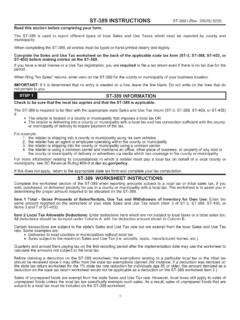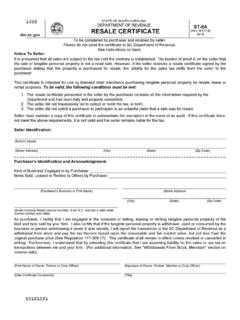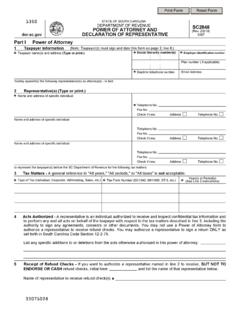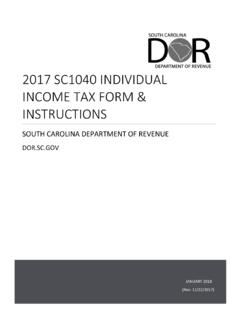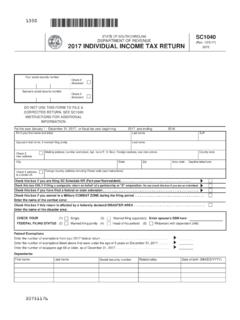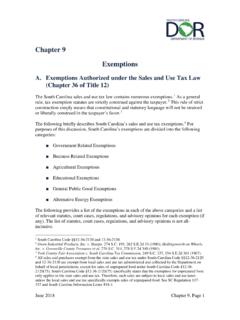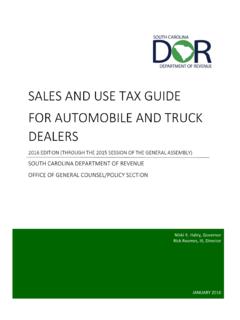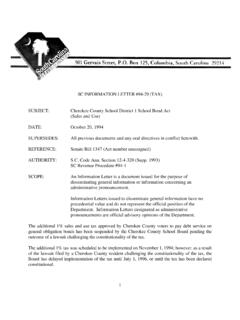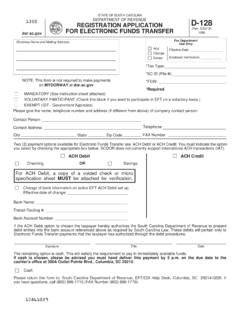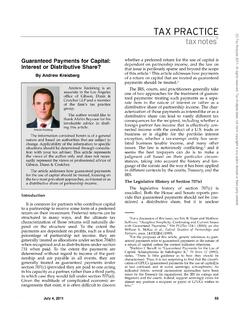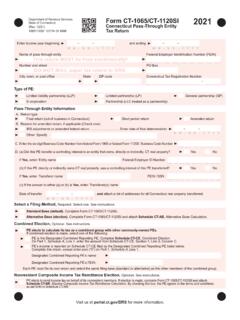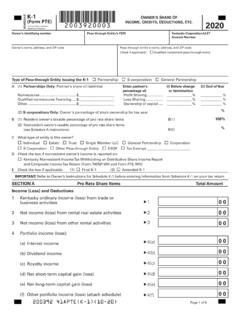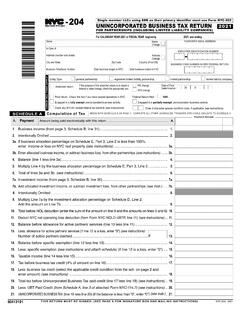Transcription of 1350 STATE OF SOUTH CAROLINA DEPARTMENT OF …
1 1350 STATE OF SOUTH CAROLINA . DEPARTMENT OF REVENUE I-435. ACTIVE TRADE OR BUSINESS INCOME FOR (Rev. 9/23/21). ELECTING PARTNERSHIPS AND S CORPORATIONS 3402. Complete one I-435 for each return Attach the I-435 to your SC1065 or SC1120S 2021. For the year January 1 - December 31, 2021, or fiscal tax year beginning 2021 and ending 2022. Name of Partnership or S Corporation FEIN. Partnerships, S Corporations, and LLCs taxed as a Partnership or S Corporation must complete this form to use the flat rate on active trade or business income. Distributive Share Items: Column A Column B Column C. Federal Schedule Schedule SC-K SC active trade or K amounts amounts business amounts 1. Ordinary business income (loss) 1. 2. Net rental real estate income (loss) 2. 3. Other net rental income (loss) 3. 4. guaranteed payments * 4. 5. interest income 5.
2 6. Ordinary/qualified dividends 6. 7. Royalties 7. 8. Net short-term capital gain (loss) 8. 9a. Net long-term capital gain (loss) 9a. 9b. Collectibles (28%) gain (loss) 9b. 9c. Unrecaptured section 1250 gain 9c. 10. Net section 1231 gain (loss) 10. 11. Other income (loss) 11. 12. Section 179 deduction 12. ( ). 13 Other deductions 13. 14. Self-employment earnings (loss)* 14. 15. Credits 15. 16. Foreign transactions 16. 17. Alternative minimum tax (AMT) items 17. 18. Tax exempt income and nondeductible 18. expenses*. 19. Distributions* 19. 20. Items affecting shareholder basis** 20. 21. Other information 21. 22. Total active trade or business income (add amounts in Column C). Enter here and on 22. your SC1065, line 2 or on your SC1120S, line 5. 23. Total active trade or business income taxed by another partnership or S Corporation 23.
3 (from SC K-1s received). 24. Taxable active trade or business income (subtract line 23 from line 22) 24. 25. Active Trade or Business Income Tax (multiply line 24 by 3%). Enter here and on 25. your SC1065, line 3 or on your SC1120S, line 6. The I-435 combines elements of federal Schedule Ks for the 1065 and the 1120-S. * Items on the 1065, Schedule K but not on the 1120-S, Schedule K. ** Items on the 1120-S, Schedule K but not on the 1065, Schedule K. 34021212. INSTRUCTIONS. Beginning with the 2021 tax year, a qualified entity can elect to have its active trade or business income taxed at a 3% flat tax rate imposed on the entity itself instead of its qualified owners. Electing qualified entities must use the I-435 to identify active trade or business income and calculate the tax. A qualified entity is a Partnership, S Corporation, or LLC taxed as a Partnership or S Corporation whose owners are all qualified owners or partnerships directly owned by qualified owners or by qualified owners through other partnerships.
4 A qualified owner is a partner, shareholder, or member of a qualified entity who is: an individual a trust an estate an entity type not included in SC Code Sections 12-6-530 through 12-6-540 and 12-6-550 and not exempt from SOUTH CAROLINA Income Tax Qualified entities elect each year whether or not to have the active trade or business income taxed at the entity level. The election must be made by the due date for filing the applicable Income Tax return, including any extensions. Active trade or business income is apportioned by the entity according to SC Code Section 12-6-2240. Active trade or business income does not include passive investment income and related expenses or capital gains and losses. No amounts included in active trade or business income should be treated as income from personal services allocated based on SC Code Section 12-6-2220(6).
5 For more information, SC Code Sections are available at Line instructions Enter amounts from the federal Schedule K in Column A. Enter amounts allocated or apportioned to SOUTH CAROLINA from the Schedule SC-K in Column B. Enter SOUTH CAROLINA active trade or business amounts in Column C. Amounts entered in Column C should not be greater than the amounts entered in Column B. Line 1: Ordinary business income (loss). In Column C, enter amounts from Column B that are not capital gains or losses or passive investment income or losses. Line 2 and Line 3: Net rental real estate income (loss)/other net rental income (loss). In Column C, enter from Column B only rental income from the active trade or business of renting property if, based on all the facts and circumstances, the pass-through business either provides significant services or has substantial expenses in the rental business.
6 The determination is based in part on the number of people employed to provide services and the types and amounts of expenses, other than depreciation. Examples of qualifying rents are those from operating a hotel or a short-term car rental business. See IRC Section 1362(d) and applicable regulations for more information. Line 4: guaranteed payments (from partnerships). In Column C, enter Column B guaranteed payments for use of capital that are not passive investment income. Do not include guaranteed payments for services. Line 5: interest income interest income is considered passive income and is not included in Column C unless it results from the sale of: stock in trade inventory property held for sale to customers in the ordinary course of trade or business services performed in the ordinary course of trade or business Line 6: Ordinary/qualified dividends Dividends are not included in active trade or business income or loss because they are passive investment income.
7 Line 7: Royalties Royalties are considered passive investment income and are not included in Column C unless they are from the ordinary course of a trade or business of franchising or licensing property, or are active business computer software royalties as defined in IRC Section 543(d). Line 8 through line 9c: Net short-term and long-term capital gains (losses), collectibles (28%) gain (loss), and unrecaptured section 1250 gain Active trade or business income or loss does not include these amounts. Line 10: Net section 1231 gain (loss). After determining if gains and losses are capital , enter in Column C the net of ordinary gains and losses, but not capital gains or losses. Line 11: Other income (loss). In Column C, do not enter Column B capital gains or losses or passive investment income or losses. Line 12: Section 179 deduction In Column C, enter amounts from Column B that are not capital gains or losses or passive investment income or losses.
8 Line 13, Line 14, and Line 15: Other deductions, self-employment earnings (loss), and credits Active trade or business income or loss does not include these amounts. Line 16: Foreign transactions In Column C, adjust for any Column B foreign income exclusion if it: increases or decreases active trade or business income, and affects taxable income that is not passive investment income or expenses related to passive investment income Line 17 through Line 21: Alternative minimum tax (AMT) items, tax exempt income and nondeductible expenses, distributions, items affecting shareholder basis, and other information Active trade or business income or loss does not include these amounts. Line 22: Total active trade or business income Add amounts in Column C. Enter the total active trade or business income to be taxed at the entity level on line 2 of the SC1065 or line 5 of the SC1120S.
9 Line 23: Total active trade or business income taxed by another partnership or S Corporation Enter amounts that were already taxed, as shown on the SC K-1s provided by another partnership or S Corporation. Line 24: Taxable active trade or business income Subtract line 23 from line 22. Line 25: Active Trade or Business Income Tax Multiply line 24 by 3%. This is your tax on active trade or business income. Enter this amount on line 3 of the SC1065 or line 6 of the SC1120S. Find more information about the Active Trade or Business Income Tax for pass-through entities at Social Security Privacy Act Disclosure It is mandatory that you provide your Social Security Number on this tax form if you are an individual taxpayer. 42 405(c)(2)(C)(i). permits a STATE to use an individual's Social Security Number as means of identification in administration of any tax.
10 SC Regulation 117-201 mandates that any person required to make a return to the SCDOR must provide identifying numbers, as prescribed, for securing proper identification. Your Social Security Number is used for identification purposes. The Family Privacy Protection Act Under the Family Privacy Protection Act, the collection of personal information from citizens by the SCDOR is limited to the information necessary for the SCDOR to fulfill its statutory duties. In most instances, once this information is collected by the SCDOR, it is protected by law from public disclosure. In those situations where public disclosure is not prohibited, the Family Privacy Protection Act prevents such information from being used by third parties for commercial solicitation purposes.
